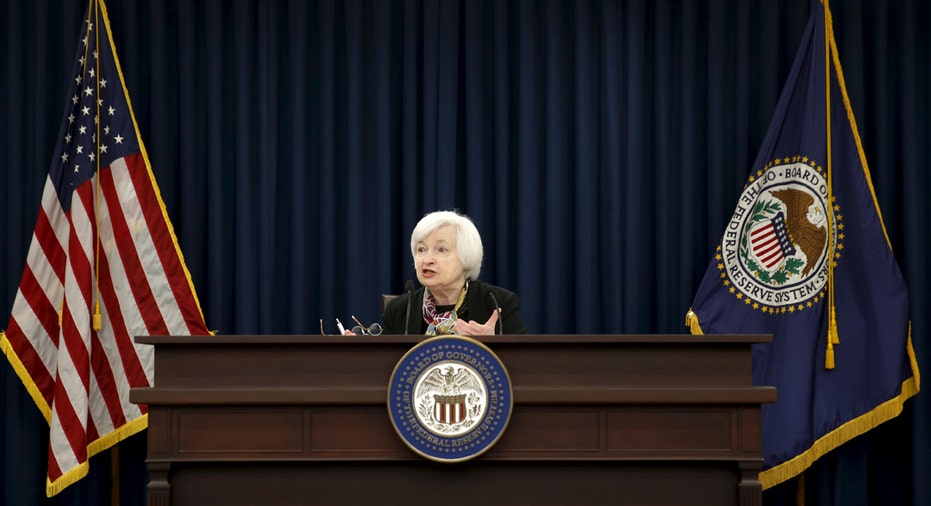Fed Holds Rates Steady, Lowers Forecast for Number of Hikes in '16

The Federal Open Market Committee on Wednesday opted to hold short-term interest rates steady at 0.25% to 0.50%, and lowered its expectation from four more rate increases in 2016 down to two more hikes.
In the statement, the FOMC cited global economic and financial developments as risks to the U.S. outlook. Members of the committee lowered their overall 2016 GDP expectation to 2.2% from the 2.4% view at its December meeting. The 2017 GDP outlook was also revised lower to 2.1% from 2.2%, while 2018 forecasts remained at 2% growth.
Meanwhile, the Fed’s closely-watched PCE inflation projection (a measure of changes in the prices of consumer goods and services) was held steady at 1.6%.
“Inflation is expected to remain low in the near term, in part because of earlier declines in energy prices, but to rise to 2% over the medium term as the transitory effects of the declines in energy prices and import prices dissipate and the labor market strengthens further,” the statement read.
The central bank said it will continue to monitor the inflation picture and continued improvement in the labor market. In the press conference following the decision, Fed Chief Janet Yellen reiterated past insistence that the central bank’s policy is not on a “pre-set course,” and policy assessments will continue to evolve as more data is analyzed.
Bankrate Chief Financial Analyst Greg McBride, in a note, said while the Fed’s assessment of the economy was largely positive, the global landscape is still keeping it on the sidelines for now.
“The Fed didn’t exactly tee things up for a rate hike at the next meeting. If inflation continues to pick up, the Fed will have some serious jawboning to do,” he said.
On the heels of the decision, U.S. equity markets posted moderate gains. In recent trade, the broader averages saw a 0.6% rise, while the Nasdaq moved up 0.8%. The financial sector was one of the worst-performing of the 10 S&P 500 sectors since the FOMC was not as hawkish as expected.
“It’s tough for us to believe that two-year yields and rate-hike expectations are going to stay down with the U.S. dollar weakness and higher commoditiy prices. So worries over financials dragging the market down will likely be overdone,” Dennis DeBusschere, senior managing director at Evercore ISI, said in a note.
The yield on the benchmark 10-year U.S. Treasury bond declined 0.030 percentage point to 1.929%. Yields move inversely to prices. Meanwhile, the U.S. dollar slipped 0.87% against a basket of global currencies.
Ratcheting Up Expectations
The Federal Reserve has been the elephant on the trading floor for the better part of a year. In December, the U.S. central bank raised short-term interest rates for the first time in nearly a decade to a range of 0.25% – 0.50% from a near-zero bound. At the conclusion of that meeting, Yellen said the FOMC anticipated four more rate hikes before the end of 2016.
But an upheaval in global markets at the start of the year threw a wrench in the Fed’s plans.
Concerns about global economic growth ricocheted through markets all over the globe, including the U.S., and with it, expectations for rate hikes were pushed back to 2017 at the earliest while investors worried about renewed jitters over China’s growth rate, renewed pressure in the oil patch and weak U.S. economic data.
Since then, though, equity markets have recovered substantial losses as the U.S. economic picture has improved somewhat, the job market continues to improve and inflation moves further toward the Fed’s 2% target.
Bryce Doty, portfolio manager at Sit Rising Rate ETF, said the Fed has backed itself into a corner trying to effectively telegraph its intentions on monetary policy. He said, essentially, there’s no reason for rates to remain this low.
“Nothing needs to improve in the economy,” he said. “Without a shock, I would expect the Fed to raise rates in June. All they have to do between now and then is manage expectations because all the economic strength they need is as good or better than it was in December.”
Ahead of the March statement on Wednesday, markets had priced in a 50-50 chance of at least one rate hike in June. That probability was lowered a bit from 58% to 41% after the 2:00 statement. Further, expectations for at least one rate hike by the end of the year decreased from 85% to 70%.



















